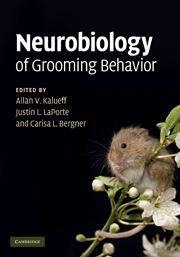Book contents
- Frontmatter
- Contents
- List of contributors
- Preface
- 1 Grooming, sequencing, and beyond: how it all began
- 2 Self-grooming as a form of olfactory communication in meadow voles and prairie voles (Microtus spp.)
- 3 Phenotyping and genetics of rodent grooming and barbering: utility for experimental neuroscience research
- 4 Social play, social grooming, and the regulation of social relationships
- 5 Grooming syntax as a sensitive measure of the effects of subchronic PCP treatment in rats
- 6 Modulatory effects of estrogens on grooming and related behaviors
- 7 Lack of barbering behavior in the phospholipase Cβ1 mutant mouse: a model animal for schizophrenia
- 8 Grooming after cerebellar, basal ganglia, and neocortical lesions
- 9 Striatal implementation of action sequences and more: grooming chains, inhibitory gating, and the relative reward effect
- 10 An ethological analysis of barbering behavior
- 11 Should there be a category: “grooming disorders?”
- 12 Neurobiology of trichotillomania
- Index
- References
6 - Modulatory effects of estrogens on grooming and related behaviors
Published online by Cambridge University Press: 04 August 2010
- Frontmatter
- Contents
- List of contributors
- Preface
- 1 Grooming, sequencing, and beyond: how it all began
- 2 Self-grooming as a form of olfactory communication in meadow voles and prairie voles (Microtus spp.)
- 3 Phenotyping and genetics of rodent grooming and barbering: utility for experimental neuroscience research
- 4 Social play, social grooming, and the regulation of social relationships
- 5 Grooming syntax as a sensitive measure of the effects of subchronic PCP treatment in rats
- 6 Modulatory effects of estrogens on grooming and related behaviors
- 7 Lack of barbering behavior in the phospholipase Cβ1 mutant mouse: a model animal for schizophrenia
- 8 Grooming after cerebellar, basal ganglia, and neocortical lesions
- 9 Striatal implementation of action sequences and more: grooming chains, inhibitory gating, and the relative reward effect
- 10 An ethological analysis of barbering behavior
- 11 Should there be a category: “grooming disorders?”
- 12 Neurobiology of trichotillomania
- Index
- References
Summary
Summary
Both the estrogen-synthesizing enzyme and estrogen receptors are present in the brain. The distribution of estrogen-sensitive cells in the brain corresponds to regions that control sexual differentiation, masculine and feminine sexual behaviors, and aggressive behaviors as well as grooming. All these are indicative that estrogens play diverse roles in several neural circuits. From observing animal models and psychiatric patients, it is evident that estrogens have modulatory effects on grooming and related behaviors.
Introduction
Traditionally viewed as female reproductive hormones, estrogens have in the past decade been shown to have widespread biological actions in both males and females. Estrogens are C-18 steroids derived from cholesterol and occur naturally in the human body in three different forms: 17β-estradiol (E2), estrone (E1), and estriol (E3) (Young et al. 1964). The last step in estrogen biosynthesis is the aromatization of androgens, including testosterone and androstenedione, to estradiol and estrone respectively. In addition to the reproductive organs, estrogens are expressed in many tissues including: breast, fat, muscle, bone, and brain (Carreau et al. 1999; Jenkins et al. 1993; Sasano and Ozaki 1997; Sasano et al. 1997, 1998; Simpson et al. 1997a). Investigations on the mechanism of action of estrogens have escalated greatly over the past decade due to the discovery of three types of estrogen receptors: estrogen receptor α (ERα; Green et al. 1986) estrogen receptor β (ERβ; Kuiper et al. 1996), and membrane ER (ERX; Watson et al. 1999). However, the last is probably ERα in most cases.
- Type
- Chapter
- Information
- Neurobiology of Grooming Behavior , pp. 108 - 130Publisher: Cambridge University PressPrint publication year: 2010
References
- 1
- Cited by



